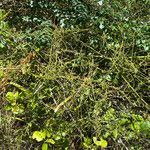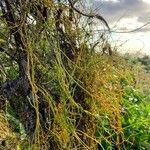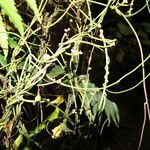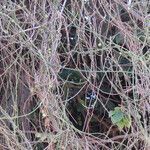Dextrorsely twining herbs forming masses of brownish or greenish-yellow threads over low vegetation; stems up to 2 m long, filiform, striate, branched, glabrous to tomentose, green, bright brown or bright yellow. Leaves scale-like, 1.5-2 mm long, ovate to lanceolate, apex acute. Inflorescence an axillary spike 1-6 cm long, usually solitary, 3-10-flowered; peduncle 1-3 cm long; bracts and bracteoles c. 0.6 mm long, ovate, ciliate. Receptacle glabrous. Flowers greenish-white, sessile, 1.5-2 mm long, glabrous; the 3 outer tepals 0.6-1 mm wide, broadly ovate-orbicular and ciliate, the 3 inner tepals 1.8-2.4 x 1.5-2 mm, ovate-triangular, obtuse at the apex, glabrous inside and outside, ± fleshy. Stamens 9, arranged in 3 whorls with an innermost or fourth whorl made up of staminodes; filaments of the first and second whorls c. 0.3 mm long, anthers c. 1 x 0.6 mm, dehiscing introrsely; filaments of the third whorl c. 0.2 mm long with 2 globose glands at the base, anthers c. 0.9 x 0.3 mm, dehiscing extrorsely; staminodes c. 0.4 mm long, triangular, glabrous, fleshy. Ovary 0.3 mm long, ovoid; style 0.3 mm long. Fruit drupaceous, c. 6 x 5 mm, globose, surrounded by the glabrous accrescent receptacle, crowned with a persistent perianth.
Stem green-brown, filiform, slightly woody, rusty pubescent when young but sparsely pubescent or glabrous when mature. Leaves reduced to minute scales. Spike ca. 2.5 cm, densely rusty pubescent; bracts and bracteoles brown, minute, broadly ovate, ca. 1 mm, ciliate. Flowers white, small, less than 2 mm, sessile. Perianth lobes 6, in 2 series, outer 3 small, orbicular, ciliate, inner 3 larger, ovate, all pubescent outside, subglabrous inside. Fertile stamens 9; filaments of 1st whorl subpetaloid, those of 2nd and 3rd whorls filiform, of 3rd whorl each with 2 stalkless glands, others glandless; anthers 2-celled; cells of 1st and 2nd whorls introrse, those of 3rd whorl extrorse. Staminodes 3, stalked. Ovary ovoid, subglabrous; style short, slightly angled; stigma small, capitate. Fruit small, ovoid, included in dilated and fleshy perianth tube after anthesis, free, with persistent lobes on top. Fl. and fr. May-Dec.
Parasitic, twining herb, with thread-like, yellowish stems up to 2 m long, 1 mm thick, pubescent to glabrous; covering up to 10-30 m vegetation; adhering to hosts by uniseriate, elliptic haustoria 1-2 mm long. Leaves 1.0-2.5 mm long, scale-like. Flowers globose-ovoid, 1-2 mm long. Tepals in 2 rows of 3, small; outer ones smaller, triangular, glabrescent, ciliate; inner ovate to oblong, glabrous. Stamens (6-)9, white, drying brown; staminodes (outer whorl) pyramidal, stalked. Ovary ellipsoid, glabrous, with a ring of hairs. Flowering time all year. Fruit ovoid to subglobose, red. Seed globose, blackish.
A fine straggling leafless creeper or vine that climbs over plants and gets at least some if its food from the other plants. The leaves are very small and like scales, and clasp the stem. The stem is orange to yellow and twines around plants, attaching by small suckers. The flower is small and the sepals are like bracts. The petals are white and fleshy. The flowers are 0.1-0.2 cm long. It has very small, berry-like fruit (4-5 mm across) which are green when young and turn white when ripe. The flesh is clear and the black seed can be seen from the outside.
Stems twining, pale green to yellow-green to orange, filiform, glabrous or pubescent. Leaves alternate, ca. 1 mm. Inflorescences spikes, rarely reduced to single flower. Flowers bisexual, subtended by ciliate bract and bracteoles; outer 3 tepals 0.1-1 mm, similar to bracteoles, inner 3 tepals 1-1.8 mm, apex incurved; pistil 1.2 mm, glabrous. Drupe to 7 mm diam. 2 n = 48.










